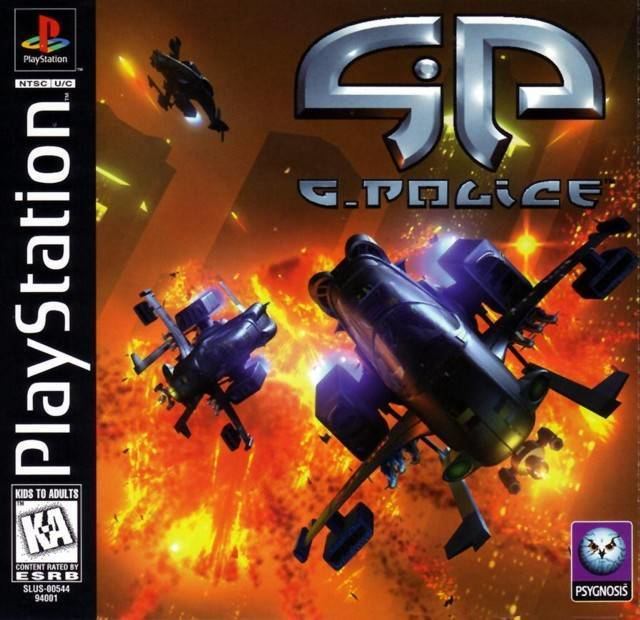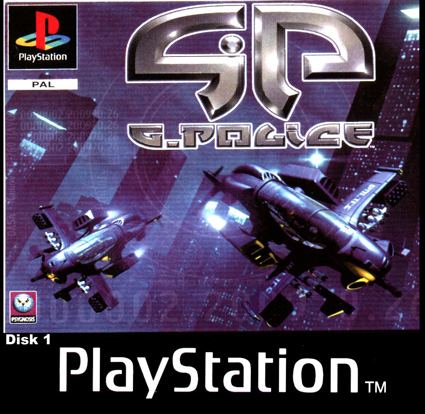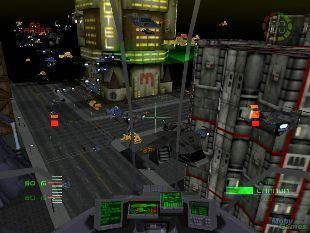9.2 /10 1 Votes9.2
8/10 IGN Initial release date 1997 | 4.9/5 Emuparadise 5/5 XTC Abandonware Genre Shooter game | |||||||||||||||||||||||||||||||||
 | ||||||||||||||||||||||||||||||||||
Similar Psygnosis games, Shooter games | ||||||||||||||||||||||||||||||||||
G police game sample playstation
G-Police is a shooter video game, developed and published by Psygnosis in 1997 for the PlayStation and PC. The game spawned a single sequel, G-Police: Weapons of Justice, released in 1999 for the PlayStation. This sequel received similar reviews to those of the original game. In 2007, G-Police was made available for download on the PlayStation Network (Europe only).
Contents
- G police game sample playstation
- G police walkthrough campaign mission 1 all objectives completed
- Setting
- Story
- Gameplay
- Development
- Awards
- Reception
- Sequel
- References

The game has a science-fiction setting, inspired by Blade Runner. The story takes place in the year 2097, on a colonised Callisto (one of Jupiter's moons). The game charts the protagonist Slater's attempts to discover the truth behind his sister's mysterious death while working for the titular G-Police. The game begins with the G-Police combating organised criminals before fighting the private armies of powerful corporations in an unfolding conspiracy-themed plot. The gameplay involves piloting VTOL aircraft resembling helicopters, engaging in combat with enemies and protecting allies.

The game made use of cutting edge technology such as force–feedback joysticks and controllers, 3D sound and Direct3D Hardware Acceleration and was largely well received. Critics noted that the game's graphics were some of the most technically impressive of the time. Overall, however, critics had mixed response for the graphics, as the demanding graphics resulted in poor draw distance; in particular, the PlayStation version struggled in this aspect. In general, the gameplay was favourably reviewed, with critics praising the solid, enjoyable missions, though there were complaints regarding a poor control system and unfairly high levels of difficulty.

G police walkthrough campaign mission 1 all objectives completed
Setting

The game is set in 2097, according to the introductory sequence. This sequence also provides the history of the game’s setting: in 2057, the depletion of Earth’s resources coincided with widening space exploration. After a catastrophic war over ever-declining resources, ending 10 years prior to the events of G-Police, Earth’s governments were stripped of military power. As a result, powerful corporations had exerted control over Earth and the burgeoning space colonies. The Government Police (G-Police) was formed by Earth’s remaining coalition government to maintain order in these colonies.

In the latter part of the introductory sequence, Slater, the game's protagonist, introduces himself as a war veteran who had joined the G-Police to conduct his own investigation of his sister Elaine’s apparent suicide, suspecting that she was murdered. He also provides his view of the G-Police, stating they lack authority and “turn a blind eye” to “shady corporate deals” while attempting to maintain order. He describes the Havoc gun-ships as outdated and the pilots as a mixture of desperate war veterans and naïve idealists.
Story
The early levels of the game depict Slater combating enemy gangs. The G-Police suspect "Krakov" corporation is supplying the gangs with weaponry. Krakov’s president however is subsequently the subject of an assassination attempt by the gangs. During this attempt, Tachikawa (a pilot whom Slater describes as flying his gun-ship "like he was born in it") dies when his gun-ship crashes after mysteriously malfunctioning. In the interests of morale, his death is covered up; Slater notes this incident is reminiscent of Elaine’s death.
After numerous terrorist attacks on their personnel and property, Krakov blames a rival corporation, "Nanosoft", and begins openly attacking them with its private army. Lacking evidence for involvement with the criminal gangs, the G-Police protect Nanosoft, ultimately destroying Krakov’s military power. The latter half of the game depicts a conflict between the G-Police and Nanosoft’s private forces, which attack G-Police after Krakov’s collapse.
In the unfolding plot, the player learns that Tachikawa and Slater’s sister, Elaine, were killed (by the sabotage of their gun-ships) to procure microchips implanted in their brains. These chips can record a pilot's knowledge and combat skills; Nanosoft desired them to power the artificial intelligence in their weapons. The G-Police commander Horton is assassinated by Slater's traitorous wingman Ricardo, also to this end. The game ends with the destruction of a large spacecraft by Slater; the closing sequence reveals that Nanosoft had planned to use this to exert military dominance over other corporations.
Gameplay
The game involves piloting VTOL aircraft, described by critics as "jet helicopters" or "a helicopter without the rotors". The player can choose to view the action from a variety of first- or third-person perspectives, including views from within the cockpit, a variety of "chase" perspectives, including directly from above the craft (for use when bombing). Combat in G-Police involves both dogfighting with other aircraft and dropping bombs. The player is often required to "scan" suspect vehicles to determine if they are criminal or hostile. The game's aircraft comes with numerous weapons which are upgraded as the player progresses to more difficult levels. An improved version of the basic "Havoc" aircraft (the "Venom") is also available later in the game. Missions include seeking out and destroying enemies, escorting friendly ground units, preventing smuggling and bomb disposal. The player receives updates and new instructions as the mission proceeds. The main game mode features 35 missions and an additional training mode. Most of the game's mission take place in urban "domes" filled with large buildings; some, however, take place in the "outer domes", with other themes such as agrarian settings.
Development
G-Police was developed at Psygnosis' Stroud Studio. Psygnosis’ co-founder Ian Hetherington called the studio in the South of England one of their "microstudios." Staff consisted of around 70 people who were also responsible for developing Overboard! at the same time.
A television advertisement was created to publicise the game, based around an animated sequence by Peter Chung — creator of Æon Flux. The original sequence was 21 seconds long, but was shortened to allow gameplay footage to appear in the advertisement. The animation was "done entirely using traditional hand-drawn methods", according to its creator. Regarding its development, Chung also stated:
"I was at first daunted by the prospect of animating mechanical vehicles by hand that would hold up beside their computer-generated versions. I decided to concentrate on the people inside the machines, emphasizing their emotions and expressions. Also, the computer imagery was very atmospheric, with lots of lighting effects. I used multiple layers of glows, highlights, and shadows to get the drawn artwork to match the atmosphere of the game footage."
Chung claimed that the decision to "concentrate on the people inside the machines" was informed by his belief that the game’s plot, setting and characters set G-Police apart from other shooters of the day.
G-Police was backed by a reported $2.5 million advertising campaign, part of a wider $6 million campaign which also included F1 Championship Edition and Colony Wars. G-Police continued to be closely associated with Colony Wars, another science fiction shooter from Psygnosis. IGN stated prior to the games’ releases that "G-Police is that rarest of games, a thinking man's shooter, and Colony Wars looks like it'll redefine the space shoot 'em up". The online magazine indicated it was further anticipating the titles due to the credentials of the developer.
Awards
G-Police was awarded the "Creative Labs Best Use of Innovative Technology" award at the PC Zone awards ceremony 1997.
Reception
IGN noted the scifi influence on the game’s visuals and setting and praised the game’s expansion of the theme. The online magazine however derided the graphics as the "low point of the game", pointing to the "terrible" draw distance and building textures. Nevertheless, the game was redeemed by its solid gameplay and attention to detail, and was awarded a rating of 8/10. Though Edge disagreed regarding the buildings' detail, praising them, the magazine agreed that the game stretched the PlayStation's capabilities too far, though it was less harsh, calling the draw distance the "only fly in the ointment"; the magazine noted that these problems were alleviated somewhat in the PC version. Edge praised the large city environments, flight simulation (noting the support for the DualShock controller), "marvellous" cut scenes and "great variety and imagination" of the playable missions, giving the game an 8/10 rating.
Next Generation Magazine praised the game's support of recent technical innovations, particularly force–feedback joysticks, 3D sound, and Direct3D Hardware Acceleration. The magazine also praised the graphics (again noting the scifi influence), responsive controls and enjoyable gameplay. However, the reviewer complained that the game became overly difficult after the first few missions and that the verbal instructions were easily missed. The magazine also recommended the PC version of the game over the PlayStation version due to improved graphics.
Previewing the game, James Glave from GameSpot called the city environments "clean and generic", though he noted the "Logan’s Run-style" domes. However, he did praise the game for its weapon effects. Ultimately however, GameSpot gave both versions . Joe Fielder, reviewing the PlayStation version, held a mixed opinion of the game's graphics, praising the explosions and gunfire effects while criticising the draw distance. He also derided the missions as being repetitive. Mark East praised the PC version's graphics as "quite possibly the best looking game to hit the scene since the advent of 3D-accelerator cards" and noted the "unprecedented" quality of the cut scenes. While he highly praised the graphics in addition to plot and sound, East claimed serious flaws in the gameplay, particularly the unintuitive controls and "downright ludicrous" level of difficulty.
Sequel
G-Police: Weapons of Justice is the sequel to G-Police, released in 1999 for the PlayStation. The game depicts the aftermath of the conflict between the G-Police and Nanosoft, which involves initial battles with gangs attempting to take advantage of the colony's instability. Later, another war arises between the G-Police and a power hungry leader of Earth's forces, originally sent to assist the G-Police against the gangs. The game features additional vehicles: a VTOL spacecraft, an armoured personnel carrier and the "Raptor"—a mech with ability to leap airborne. The game received similar reviews to the original game: IGN praised its well-crafted gameplay, story and sound, while GameSpot considered the controls awkward and the missions and setting repetitive. The graphics again received a mixed reception: IGN praised the attention to detail but criticised the poor draw distance, as did GameSpot.
In 2001, a rumoured sequel for the PlayStation 2 was reported. The rumours later proved false however. While Sony contemplated the notion of a G-Police game for the PlayStation 2 (who had bought Psygnosis, renaming it Studio Liverpool), they decided that, because G-Police was not as successful as other games, Studio Liverpool would instead concentrate on the Formula 1 and Wipeout franchises. Furthermore, the development team responsible for G-Police and Weapons of Justice had moved on to other ventures. In 2007, G-Police was made available for download on PlayStation 3. Computer and Video Games noted that the graphics looked poor by current standards but deemed it still enjoyable to play.
